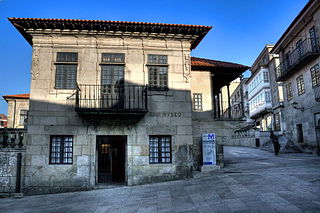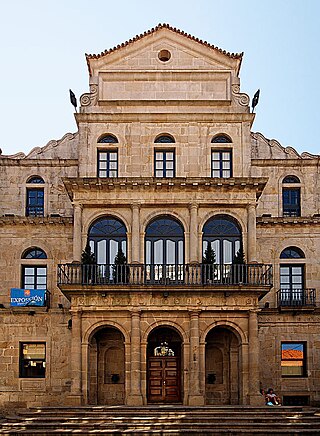
The Church of Saint Bartholomew is a Catholic religious building in the city of Pontevedra, Galicia, Spain. The church was built in the late 17th century in the Baroque style as a place of worship and pastoral activities for the adjoining Jesuit college. The church was dedicated to Saint Bartholomew when it became a parish church in 1836.

The Palace of Mugartegui, or Palace of the Counts of Fefiñáns in Pontevedra, Spain, is a Baroque pazo dating from the 18th century. It currently houses the headquarters of the Regulatory Council of the Rías Baixas Designation of Origin.

The Palace of the Counts of Maceda, or Casa del Barón in Pontevedra, Spain, is an original Renaissance pazo dating from the 16th century. It is currently a four-star hotel belonging to the Paradores network.

The Casa de las Caras, also known as the Pazo de Barbeito y Padrón, is a 16th-century building in the heart of the historic centre of Pontevedra, Spain. It is known as the House of the Heads because of the Renaissance busts that decorate its façade on the upper floor.

The building of the former Pontevedra Normal School of Pontevedra, in Pontevedra, Spain, is an eclectic building from the end of the 19th century that was the headquarters of the teacher training college of this Galician city. It is located on the Gran Vía de Montero Ríos, between the Alameda de Pontevedra and the Palm Trees Park.

The Post and Telecommunications Palace of Pontevedra is a building between Oliva and García Camba streets, in the heart of the commercial and financial centre of Pontevedra, Spain. Since its construction, it has been the main headquarters of Correos in the city and in the province of Pontevedra. In front of its main façade there is an olive tree which gave its name to the Olive Street.

The Pazo de García Flórez is an 18th century baroque pazo located between Sarmiento Street and Plaza de la Leña in the city of Pontevedra, Spain, in the heart of the old town.

The Pazo de Castro Monteagudo, is an 18th-century baroque pazo in Pasantería Street, next to the Plaza de la Leña in the city of Pontevedra, Spain, in the heart of the old town.

The Plaza de Teucro is a square of medieval origin located in the heart of the old town of Pontevedra (Spain). It is the most harmoniously proportioned medieval square in the city.

The Plaza de la Verdura is a square of medieval origin located in the heart of the historic centre of Pontevedra (Spain). It is one of the liveliest medieval squares in the city.

Méndez Núñez Square is a square of medieval origin located in the heart of the historic centre of Pontevedra (Spain).

The Plaza de la Pedreira or Plaza de Mugartegui is a square of medieval origin located in the northern part of the old town of Pontevedra (Spain).

The Liceo Casino is a neoclassical building from 1878 located in the historic centre of Pontevedra, which houses the oldest cultural and leisure society in Pontevedra, Spain.

Curros Enríquez Square is a square of medieval origin located in the heart of the historic centre of Pontevedra (Spain), on the Portuguese pilgrimage way.

The Sanctuary of the Apparitions is located in Pontevedra, Spain. According to Sister Lúcia, it was here that the child Jesus and the Virgin Mary appeared to her in December 1925 with Mary's heart surrounded by thorns and revealed to her the First Saturdays Devotion. Lúcia also said that the child Jesus visited her alone in February 1926, near the sanctuary's garden to urge her to do more to promote the Five Saturdays Devotion.

St. Joseph's Square is a 19th century square located in the centre of the city of Pontevedra (Spain), in the first urban expansion area, near the Campolongo neighbourhood.

The Plaza del Muelle or Praza do Peirao is a square of medieval origin located at the northern edge of the historic centre of Pontevedra (Spain), very close to the Burgo Bridge and the old port neighbourhood A Moureira.

The Plaza de las Cinco Calles is a square of medieval origin located in the heart of the historic centre of the city of Pontevedra (Spain).

Alonso de Fonseca Square is a medieval square located in the historic centre of the city of Pontevedra (Spain), opposite the Basilica of Saint Mary Major.

Calle Real is a street in the Spanish city of Pontevedra, located in the city's historic centre.
























